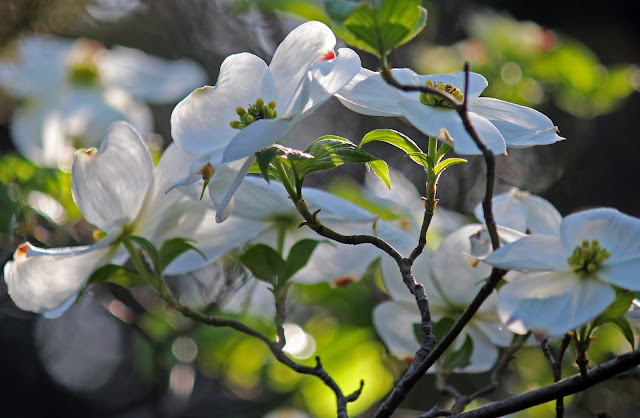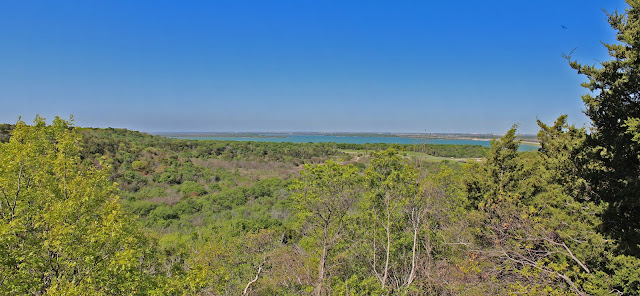 |
| Climbing high in the tree tops of a century old Flowering Dogwood (Cornus florida) stand, Dogwood Canyon, Dallas County, Texas |
 |
| Master Naturalist Bill Holston climbing a ladder into the Dogwoods |
The pioneers that first settled this land called it the Cedar Mountains. A 100 million year old escarpment of limestone sitting on top of the Eagle Ford Shale running through Dallas County. This part of Texas is traditionally known as flat Blackland Prairie. A somewhat treeless native landscape with tall grasses and wildflowers. It attracted early settlers for the rich soils perfect for growing cotton and grain. The cedar ridges of southwest Dallas County are a stark contrast to that. Rolling limestone hills, steep ravines and cedar trees by the hundreds of thousands.
 |
| Cedar Ridge Preserve in the pre-dawn light of a Texas spring sunrise in the Black-capped Vireo Habitat Management Area |
Locations and addresses:
Cedar Ridge Preserve 7171 Mountain Creek Parkway
Website:Cedar Ridge Preserve
Trail Map: Cedar Ridge Preserve Trail Map
Cedar Mountain Preserve 1300 W. FM 1382
Website: Dallas County Cedar Mountain
Trail Map: No official map available
Dogwood Canyon Audubon Center 1206 W FM 1382
Website:Dogwood Canyon Audubon Center
Trail Map: Dogwood Canyon Trail Map
No horses or mountain bikes allowed on those properties. Options for mountain biking in this area include the DORBA trail at Cedar Hill State Park and Big Cedar Wilderness. All five of these locations virtually interconnect in some way with trails. There should be roughly fifty miles of trails here across the five properties. Cedar Hill State Park and Dogwood Canyon both require an admission fee. Big Cedar is on private property and requires signed waivers.
Cedar Ridge Preserve -- The Old Dallas Nature Center
 |
| Cedar Ridge Preserve's pond in the early morning light |
In 1978 the foundation running the Greenhills Experimental Center changed the name to the Dallas Nature Center. It ran for a number of years on small budgets and was eventually consolidated into the Dallas County Open Space Program.
The Dallas Audubon Society has managed the now renamed Cedar Ridge Preserve since 2003. If you have not been there in awhile I think you will be pleased with the improvements to the property. Sitting on one of the highest points in Dallas at over 750 feet and with 600 some odd acres of terrain it has become a favorite spot of trail runners due to the looping trails and array of hills. Well made trails that flow with the contours make for good stabilized routes not prone to erosion.
 |
| Spring fed limestone creek where Austin Chalk meets the Eagle Ford Shale |
 |
| View from the observation platform at Cedar Ridge Preserve looking west. Joe Pool Lake in the far distance. |
 |
| Observation platform at Cedar Ridge Preserve |
 |
| Yucca pallida and Snake warning sign |
Hiking from the ridges down to the Cattail pond on the property one crosses a number of ecological zones that house a variety of plants. Juniper, cactus and yucca dominate the high ridges. A little further down one sees the Mexican Buckeye, Mexican Plum, Sugar Hackberry and a variety of oaks including the Shin Oak.
 |
| Bluebonnets in full bloom at Cedar Ridge Preserve |
 |
| Hiking from Cedar Ridge Preserve to Cedar Mountain Preserve |
 |
| Cedar Mountain Preserve Trail head |
There was a parking lot for Cedar Mountain up until last year. In 2012 that parking lot access was combined into that of the Dogwood Canyon Audubon Center. Cedar Mountain is free to visit and unlike other nearby venues is open sunrise to sunset most of the year. If you want to see the sunset, this is the place to do it.
Dogwood Canyon Audubon Center
 |
| Under a canopy of dogwoods |
 |
| Dogwood Canyon Audubon Center |
 | |||
| Trail junction behind the Visitor Center |
The other trail, the one of most interest to those reading this will be the West Loop/ West Rim Trail. This trail gradually climbs away from the canyon floor up a series of switchbacks to the canyon rim then follows that rim around to the west and north affording great views of Joe Pool Lake and points west in Tarrant County.
 |
| The forested canyon floor of Dogwood Canyon near the visitor center |
John Wesley Penn had a thriving farm here for decades on Mountain Creek and the creek tributaries bearing his own name. He grew various crops in the lower areas, cut the meadows for hay and grazed cattle on the slopes to some extent. Mr Penn died at the hands of a rattlesnake, per the obituary below:
An Old Settler Dies From the Poisonous Effects of a Rattlesnake Bite.
Mr. John W. Penn, an old resident and respected farmer living on the mountain near Cedar Hill, in Dallas county, was bit by a rattle snake last Friday evening, from the effects of which, he died early Saturday morning. The fangs of the reptile were buried deep on the back of the hand, and as soon as he was bit, Mr. Penn declared he would never survive. His prediction was gradually verified as he poison settled deeper in his system and about midnight, he lost consciousness and became a raving maniac, four holding him in bed until death relieved his terrible suffering early Saturday morning. The snake struck the unfortunate man while he was in his field stooping over to pick up a rake from a rank growth of weeds. Mr. Penn had been living on the place twenty-five years, and he stated after he was bit that it was the largest snake he ever saw. He called to his son who was plowing in another portion of the field, who conveyed his father home. Stimulants and every remedy available were administered without effect. After its deadly work, the snake escaped in the high weeds. - June 25, 1888, Dallas Daily Herald
The rattlesnakes still grow large here. Sightings of very large rattlesnakes on the DORBA Trail at Cedar Hill State Park are very common. One of the more infamous photos that circulate the internet of a rattlesnake among bluebonnets was taken at Cedar Hill.
When Penn started his farm here, the hills were probably more of an open grass environment that kept trees and understory in check through infrequent wildfires. While it's hard to say or call anything here man made, the large number of trees here now are a climax ecosystem due to lack of fire.
 |
| Switchback up the canyon |
 |
| Mexican Buckeye Ungnadia speciosa on the West Rim Trail |
 |
| Trout Lily Erythronium albidum on the canyon floor |
Man has been up here. Who knows when. Maybe half a century ago, most likely much longer than that, someone built a ramshackle cabin of a place way up on the slopes of the ridge. Far away from the world. This was long before any road or highway existed in the area, just a little country road to Cedar Hill.
The Old Cabin
The old cabin sits just off the main trail overlooking the upper reaches of Dogwood Canyon. Built of cedar and corrugated metal siding the untouched building here is a great look into the past. Unapologetically out of fashion, a building in such state takes on a life of it's own.
 |
| View of the canyon near the cabin |
 |
| Interior of the "Old Cabin" at Dogwood Canyon Audubon Center |
The Hurt Family
 |
| David Hurt at Dogwood Canyon April 2013 |
Through their special donation, the land here was preserved and additional tracts purchased to mushroom into 200+ acres. Parcel by parcel the jigsaw pieces of land gel together to form a great sanctuary.
It would be hard to find fault in someone who wanted to keep a place like this to themselves. Sharing it with the public and working towards preserving it is really an exceptional note of altruism.
Finding The Dogwoods
 I have no idea how David Hurt found the dogwoods. They are not on a trail. Not up the bank of a creek. They sit in some mysterious place that is hard to describe.
I have no idea how David Hurt found the dogwoods. They are not on a trail. Not up the bank of a creek. They sit in some mysterious place that is hard to describe.Leaving the marked trail even Master Naturalist Bill Holston had some reservation about finding the spot. He had been there before but the route to get there involves a great bit of sleuthing.
Ecologists call the place we are head a Refugium. A quirk of the natural world where time and history bypass a place leaving old stands of plants and animals to live in a micro environment. A location of an isolated or relict population of a once widespread animal or plant species. Great Texas examples are the Lost Maples in the Hill Country and Texas Blind Salamanders in San Marcos.
Heading down slope and into the canyon the dramatic difference in the plants becomes apparent. Mushrooms, thick mosses and trout lilies abound.
 |
| Penn Creek tributary high in the canyon |
 |
| Flowering Dogwood (Cornus florida) |
Flowering dogwoods are small trees usually growing to 15-30 feet in height and are known as an understory tree in most Southern forests. The trees in Dogwood Canyon fit that bill. The stand of trees sit on somewhat flat ground at the head of a box canyon draw of sorts growing among leafy detritus of nearby oaks.
The odd bedfellow to the mix are the alkaline loving juniper that grow side by side along the dogwoods. Really strange to see as the two typically prefer different soils in which to thrive.
Difficult to explain how the trees came to thrive in such an area. Some say these trees are over a century old. Deep in a far away canyon with no buildings or farms existing in the nearby vicinity during any time in the past one wonders if humans or a true marooned plant species exist here. Lots of good questions but no good answers pointing any direction. Shrug your shoulders and just accept what you are seeing is unique. There is no other place like it.
The closest native stand of Flowering Dogwoods sit some distance east in Van Zandt county. A traditional understory tree of acidic soils the head scratching commences wondering how the trees not only came to be here but seem to thrive in an alkaline soil.
The best way to see these large dogwoods is to climb up into their canopy. Using a large ladder supported on the trunk of a juniper tree we climbed high into the branches.
The view from above is exceptional. Looking down at the forest below and the far horizon in the distance one gains a new perspective for the size of the trees here.
 |
| Looking down on the forest floor far below |
A real under the radar gem of a place. I would have a hard time finding it again as no trail exists to the spot. I think plans are in the works to open up some kind of more formal trail to the spot. If that never happens I think that would be a cool thing.
 |
| West Rim Trail view of Joe Pool Lake |
 |
| Hummingbird in a Shin Oak at Dogwood Canyon |
Our hike back saw more birds than the walk in. Hummingbirds fresh from Mexico, honeybees abuzz among the bluebonnets and buckeyes. A real eye opener to a place so many people have never been.
Cedar Ridge Preserve for miles of hiking trails, Cedar Mountain for great free sunsets and Dogwood Canyon for an overdose on what Texas is all about.







































